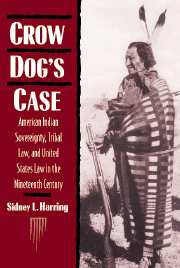 Crow Dog's Case
Crow Dog's Case Published online by Cambridge University Press: 23 September 2009
The legal history from Crow Dog to Kagama traces a relatively clear path: the U.S. Supreme Court interpreted federal Indian law to permit Congress to impose federal authority on Native Americans. Lower federal courts were then faced with dozens of individual problems calling for the application of this new law in a wide variety of legally, factually, and culturally complex situations.
This activity in the federal courts, however, documents only one aspect of the imposition of U.S. law on the tribes. Most of the intervention into the daily lives of Indian peoples took place beyond the reach of the Major Crimes Act – indeed, even beyond the reach of U.S. law in general – through the BIA's creation of two extralegal institutions. During the same period that the BIA was attempting to enact the Major Crimes Act, it established the “Indian police” in 1879 and the “courts of Indian offenses” in 1883. These were “police” and “courts” in name only. They could claim no legal status under either U.S. or tribal law. Rather, they were designed to perform important social control functions to force assimilation of the tribes under the authority of the BIA, through its Indian agents.
A major object of the imposition of this bureaucratic law at the reservation level was the destruction of tribal culture, including traditional law. Although the “law for the Indians” language of Indian reforms lay behind at least a part of the Major Crimes Act, the BIA resisted any idea of bringing the tribes under the applicable state and federal laws that governed white and black Americans.
To save this book to your Kindle, first ensure [email protected] is added to your Approved Personal Document E-mail List under your Personal Document Settings on the Manage Your Content and Devices page of your Amazon account. Then enter the ‘name’ part of your Kindle email address below. Find out more about saving to your Kindle.
Note you can select to save to either the @free.kindle.com or @kindle.com variations. ‘@free.kindle.com’ emails are free but can only be saved to your device when it is connected to wi-fi. ‘@kindle.com’ emails can be delivered even when you are not connected to wi-fi, but note that service fees apply.
Find out more about the Kindle Personal Document Service.
To save content items to your account, please confirm that you agree to abide by our usage policies. If this is the first time you use this feature, you will be asked to authorise Cambridge Core to connect with your account. Find out more about saving content to Dropbox.
To save content items to your account, please confirm that you agree to abide by our usage policies. If this is the first time you use this feature, you will be asked to authorise Cambridge Core to connect with your account. Find out more about saving content to Google Drive.